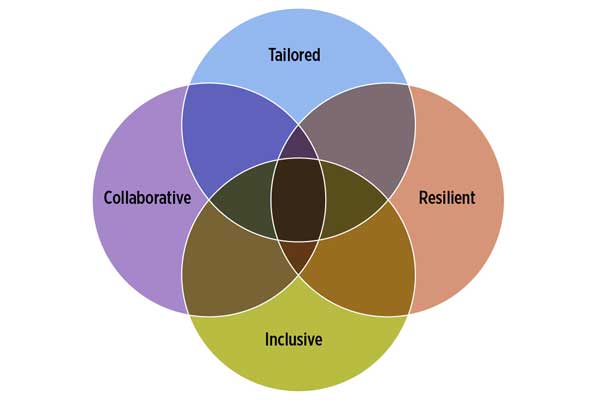The “TRIC” to Fostering Shared Economic Prosperity in Rural America
This blog post provides an overview of the first chapter released from the book “Investing in Rural Prosperity,” which was published by the Federal Reserve Bank of St. Louis in collaboration with the Federal Reserve Board of Governors. The book aims to help rural people and places navigate to a future where shared economic prosperity is a reality.
Rural communities are more likely to be successful in fostering broad-based economic prosperity if they take an asset-based, equitable approach to their development activities. In addition, success is more likely if they build from the inside on the things that make their community special, with an intentional focus on ensuring their efforts reflect and consider the needs and opportunities of all segments of the community.
That is the proposition of our book chapter, which was released Oct. 12. In the chapter, we lay out a new approach to rural development that is:

The “TRIC” approach to rural development includes tailoring the approach to the community, designing it to be resilient and being inclusive and collaborative.
- Tailored to the specific goals, assets and organizational infrastructure of the community
- Designed to be resilient to changing circumstances
- Intentionally inclusive about who is at the decision-making table and who benefits from local development
- Created and carried out through a collaborative process
We call this type of approach the “TRIC” to fostering shared economic prosperity in rural communities.
Tailored: Making Certain the Strategy Fits the Place
Attempts to support shared economic prosperity in rural places will be most effective when they are tailored to the specific community in which they are being carried out.
This means the strategy is fashioned around the community’s goals and the assets available at the time that strategy is being developed. Rural development activities should also reflect the organizational capacity in a community because every place has a different history and so has evolved with a unique set of institutions.
Resilient: Designing for Durable Adaptability
To have long-lasting, positive effects on the community, rural development efforts must be structured in a way that is resilient to both the sudden shocks and the gradual changes that will undoubtedly occur over time.
When a community encounters changing dynamics, it needs to be able to respond and adapt throughout these shifts. To the greatest extent possible, this need for resiliency should be built into the way communities plan for and structure their rural development activities. This means not being overly reliant on one person, one organization or one industry.
To be resilient, rural development strategies also need to be future-oriented, flexible and continuously evaluated.
Inclusive: Engaging and Benefiting the Full Community
To truly advance shared economic prosperity in a rural place, development activities must be inclusive of everyone living in the community, especially those traditionally on the sidelines.
Taking an inclusive approach means more than just inviting a couple of people into the existing process to expand representation of diverse groups; it means rethinking the community’s entire approach. Inclusiveness also often means reassessing who gets to decide what matters by ensuring that traditionally marginalized groups have a seat at the decision-making table—not only to have their voices heard but to exercise decision-making power.
Ensuring that all community members benefit from growth and prosperity will strengthen the fabric of the community itself and lead to a stronger economy overall.
Collaborative: Advancing Further Together
Rural communities are more equipped to advance shared prosperity when people throughout the community, and across multiple communities, collaborate to formulate and implement development strategies.
Communities that achieve success over time pursue cross-sector approaches, whereby leaders from the nonprofit, for-profit, financial, government and philanthropic sectors work together. However, even if a rural community works well across sectors within its own borders, it may still struggle to marshal the resources needed to make the most of the opportunities available to it. This is when regional collaboration is necessary.
The TRIC to Leveraging Assets
Rural communities are incredibly diverse: each with its own history, culture, and industrial and demographic mix. But no matter their history or present circumstances, every rural community has a wealth of assets that can be leveraged to foster shared economic prosperity for all living there.
To make the best use of those assets, rural communities should tailor their approach, build it on a foundation of resilience and inclusivity, and proceed collaboratively at every step of the way.
This blog explains everyday economics and the Fed, while also spotlighting St. Louis Fed people and programs. Views expressed are not necessarily those of the St. Louis Fed or Federal Reserve System.
Email Us



